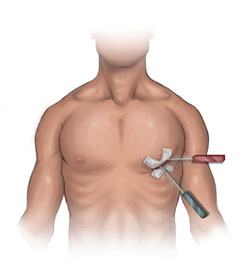Keyhole Coronary Bypass Surgery

A Less Invasive Option for Patients Needing Coronary Artery Bypass
Coronary artery bypass grafting (CABG) is a surgical procedure that is used to improve blood flow to the heart. The procedure involves grafting a blood vessel from another part of the body, such as the chest, leg, or arm, to a coronary artery that is blocked or narrowed. This allows blood to bypass the blockage and flow more freely to the heart.
Traditional CABG surgery involves a large incision in the chest called a sternotomy, where the breastbone is divided with a special surgical saw. Whilst this incision is used routinely for most types of heart surgery, very successfully, it can lead to pain and longer recovery time.

In recent years, there has been a growing interest in minimally invasive or keyhole approaches to CABG where incisions are made between the rib spaces to avoid cutting any bones at all.
Keyhole coronary bypass surgery, also known as minimally invasive direct coronary artery revascularization (MIDCAB), is a type of CABG that is performed through a small incision over the left side of the chest. The surgeon enters the chest cavity between the ribs meaning that there is no broken bone.
This is called a left minithoracotomy. This approach can offer several advantages over traditional CABG, including:
- Less pain: Because the incisions are smaller, and do not require bone division, there is less tissue damage and pain after surgery.

- Faster recovery: Patients who have keyhole CABG are typically able to go home from the hospital sooner than those who have traditional CABG. The minithoracotomy heals in 7 to 10 days while sternotomy takes at least 12 weeks to knit together.

- Lower risk of complications: The risk of infection, bleeding, and other complications is lower with keyhole CABG than with traditional CABG when the keyhole procedure is performed by an experienced surgeon.
Single-vessel keyhole CABG or MIDCAB
Some surgeons have been performing double, triple and even quadruple bypass using keyhole successfully in patients who are suitable for several years.
Two techniques can be used to achieve this:
Multi-vessel keyhole coronary bypass surgery involves grafting blood vessels from another part of the body to two or more coronary arteries that are blocked. The surgery is performed through a small incision in the chest, just like the MIDCAB procedure described above. This procedure is an extremely highly skilled procedure performed by only a handful of surgeons world-wide. Led by Mr Birdi, our team at The Keyhole Heart Clinic have been performing multi-vessel keyhole CABG for several years with excellent outcomes.
Hybrid coronary bypass surgery is a combination of keyhole coronary bypass surgery and coronary artery stenting. Stents are small, mesh tubes that can be inserted into a narrowed coronary artery to open it up. The surgery is performed through a small incision in the chest and may also involve a small incision in the groin.
How Keyhole Coronary Bypass Surgery Works
Keyhole coronary bypass surgery is performed under general anesthesia. The surgeon makes a small incision in the chest, between the ribs. A camera is sometimes inserted through a small port incision, and the surgeon uses the camera to view the heart and the coronary arteries. 

The surgeon then uses a small, thin tube called a graft to bypass the blockage in the coronary artery.
The graft can be a blood vessel from the chest, leg and/or arm.
The entire surgery typically takes about two to three hours. After surgery, the patient is taken to the intensive care unit (ICU) for monitoring. Most patients can go home from the hospital within 3-5 days.
Recovery After Keyhole Coronary Bypass Surgery
The recovery period after keyhole coronary bypass surgery is typically shorter than the recovery period after traditional CABG surgery.

Most patients can go home from the hospital within a few days.
They may experience some pain and discomfort, but this can usually be managed with simple medication. Patients are encouraged to remain active and can return to light exercises after 3 to 4 weeks.
Risks of Keyhole Coronary Bypass Surgery
As with any surgery, there are some risks associated with keyhole coronary bypass surgery. These risks include, bleeding, infection, heart rhythm problems, stroke, death, and conversion to traditional sternotomy. The risk of complications is generally lower with keyhole coronary bypass surgery than with traditional CABG surgery when the procedure is performed by an experienced surgeon who has selected you as suitable for keyhole CABG.
Clinical Evidence Scientific Papers:
Minimally Invasive Direct Coronary Artery Bypass (MIDCAB) versus Sternotomy CABG

- Bonatti et al. (2011) conducted a systematic review of 13 studies that compared MIDCAB with sternotomy CABG. They found that MIDCAB was associated with a shorter hospital stay, less pain, and a faster return to normal activities. However, there was no difference in the risk of death or major complications between the two procedures.
- Thielmann and Leyh (2013) performed a critical review of the literature on MIDCAB. They concluded that MIDCAB is a safe and effective procedure for patients with single-vessel coronary artery disease. However, they also noted that MIDCAB is not suitable for all patients, and that it is important to carefully select patients who are likely to benefit from the procedure.
Minimally Invasive Multi-vessel CABG (MIMCAB) versus Sternotomy CABG
- Harky et al. (2020) conducted a systematic review and meta-analysis of 14 studies that compared minimally invasive multi-vessel CABG (MIMCAB) with sternotomy CABG. They found that MIMCAB was associated with a shorter hospital stay and a faster return to normal activities. However, there was no difference in the risk of death or major complications between the two procedures.
- Ong et al. (2019) performed a meta-analysis of 13 studies that compared MIMCAB with percutaneous coronary intervention (PCI) for multivessel coronary artery disease. They found that MIMCAB was associated with a lower risk of death and stroke at 5 years. However, there was no difference in the risk of myocardial infarction between the two procedures.
- Sun et al. (2014) conducted a meta-analysis of 10 studies that compared MIMCAB with drug-eluting stent implantation (DES) for patients with triple-vessel disease. They found that MIMCAB was associated with a lower risk of death and stroke at 5 years. However, there was no difference in the risk of myocardial infarction between the two procedures.
Hybrid CABG versus Sternotomy CABG
- Patel et al. (2017) conducted a systematic review and meta-analysis of 12 studies that compared hybrid CABG with standard CABG. They found that hybrid CABG was associated with a shorter hospital stay and a faster return to normal activities. However, there was no difference in the risk of death or major complications between the two procedures.
- Deb et al. (2012) performed a systematic review of 11 studies that compared hybrid CABG with PCI for multivessel coronary artery disease. They found that hybrid CABG was associated with a lower risk of death and stroke at 5 years. However, there was no difference in the risk of myocardial infarction between the two procedures.
- Harskamp et al. (2016) performed a retrospective study of 1,000 patients who underwent either hybrid CABG or standard CABG. They found that hybrid CABG was associated with a lower risk of death and stroke at 5 years. However, there was no difference in the risk of myocardial infarction between the two procedures.
Overall, the studies reviewed suggest that minimally invasive coronary artery bypass grafting (MIDCAB), minimally invasive multi-vessel CABG (MIMCAB), and hybrid CABG are safe and effective alternatives to traditional sternotomy CABG. These procedures may be associated with shorter hospital stay, faster return to normal activities, and a lower risk of death and stroke. However, more research is needed to confirm these findings and to determine the optimal approach for each patient.
It is important to note that the studies reviewed were conducted in different settings and included patients with different demographics and medical histories. Therefore, the results of these studies may not be generalizable to all patients who undergo MIDCAB, MIMCAB, or hybrid CABG.
Layman’s Interpretation:
Minimally Invasive Direct Coronary Artery Bypass (MIDCAB) versus Sternotomy CABG:

Several studies have compared MIDCAB with traditional sternotomy CABG and have demonstrated favourable outcomes for MIDCAB in selected patients. Here are some key findings from the evidence base:
Reduced morbidity and mortality: Studies have shown that MIDCAB is associated with lower rates of complications, such as infections, bleeding, and respiratory complications, compared to sternotomy CABG.
Faster recovery and shorter hospital stay: Patients undergoing MIDCAB generally experience a quicker recovery, with shorter intensive care unit (ICU) stays and overall hospital stays compared to sternotomy CABG.
Comparable long-term outcomes: Long-term follow-up studies have indicated that the long-term survival rates and graft patency rates for MIDCAB are comparable to those of sternotomy CABG.
Cosmetic benefits: MIDCAB results in smaller incisions and minimal scarring, leading to improved cosmetic outcomes and patient satisfaction.
Minimally Invasive Multi-vessel CABG versus Sternotomy CABG:
The evidence base comparing minimally invasive multi-vessel CABG with sternotomy CABG is growing, but studies are still relatively limited. However, some key findings have emerged:
Similar short-term outcomes: Initial studies suggest that minimally invasive multi-vessel CABG can achieve comparable short-term outcomes in terms of morbidity, mortality, and graft patency compared to sternotomy CABG.
Reduced surgical trauma: Minimally invasive multi-vessel CABG is associated with less surgical trauma, resulting in reduced postoperative pain, lower blood transfusion rates, and shorter hospital stays.
Limited long-term data: Long-term follow-up data for minimally invasive multi-vessel CABG are still limited. However, early studies suggest promising long-term outcomes, with comparable survival rates and graft patency to sternotomy CABG.
Hybrid CABG versus Sternotomy CABG:
The evidence base for hybrid CABG, combining surgical and interventional techniques, is evolving. Here are some key findings from the available research:
Improved outcomes for high-risk patients: Hybrid CABG has shown potential benefits for high-risk patients with complex coronary artery disease, such as those with extensive comorbidities or severe calcification of the arteries.
Reduced morbidity and mortality: Studies have indicated that hybrid CABG may be associated with lower rates of complications and mortality compared to sternotomy CABG in selected patient populations.
Individualized treatment approach: Hybrid CABG allows for a tailored treatment strategy, combining the strengths of surgical revascularization with the minimally invasive aspects of percutaneous coronary intervention (PCI) techniques, such as angioplasty and stenting.
It is important to note that the evidence base for these procedures continues to evolve, and individual patient characteristics and preferences should be considered when selecting the most suitable treatment option. Consulting with cardiac surgeons and interventional cardiologists who specialize in these procedures can provide a more comprehensive understanding of the latest evidence and personalized recommendations.

Concluding Remarks
Keyhole coronary bypass surgery is a less invasive option for patients who need CABG surgery. This procedure can offer several advantages over traditional CABG, including less pain, faster recovery, and lower risk of complications. If you are considering CABG surgery, talk to your doctor about the different options available to you. Keyhole coronary bypass surgery may be a good option for you if you are looking for a less invasive and less risky approach to this important surgery.
Author: Mr Inderpaul Birdi, Consultant Cardiac Surgeon at The Keyhole Heart Clinic London.
Empower Yourself with our Free Video Series on Keyhole Coronary Bypass Surgery.
Discover the transformative power of Coronary Artery Bypass Surgery and take control of your heart health. Our educational videos provide essential insights, expert advice, and real-life stories to help you make informed decisions and live a healthier life.
Sign Up Now


